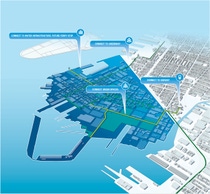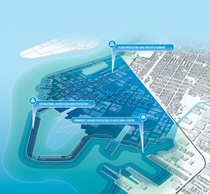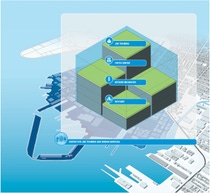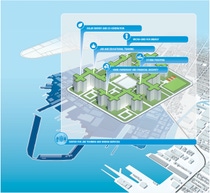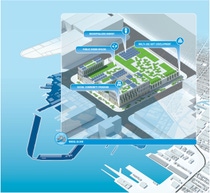Media
BASF reimagines urban coastal resilience in Red Hook, Brooklyn
Research and crowdsourced innovation co-create solutions for Red Hook and other coastal cities around the globe at risk of extreme weather
FLORHAM PARK, NJ, March 17, 2016 – BASF, a leading global chemical company at the forefront of sustainable construction solutions, released a white paper titled “Co-Creating Solutions for Urban Neighborhoods in Coastal Cities: A Look at Red Hook, Brooklyn.” It explores five solutions that would help Red Hook to resiliently and sustainably rebuild from the $32 billion in property damage Hurricane Sandy left behind in 2012, better prepare to withstand extreme weather and ultimately revitalize the neighborhood’s fledgling economy.
The ideas identified in the white paper are the culmination of BASF’s Creator Space Tour, hosted in New York City in May 2015 as part of the company’s global initiative marking its 150th anniversary. BASF engaged leading subject matter experts, including Terreform ONE and the Stevens Institute of Technology, among others, alongside Red Hook residents to crowdsource and co-create innovative solutions to transform not only the Brooklyn neighborhood, but serve as a model for other coastal cities around the globe at high risk of flooding and impacts of climate change.
“BASF sees tremendous opportunity to create a meaningful and measurable impact in Red Hook through the solutions we’ve identified,” says Michael Fletcher, Commercial Segment Manager for BASF. “Six-hundred million people call coastal cities home. And with recent studies reporting sea levels rose faster in the 20th century than the previous 2,700 years, preparing Red Hook and cities like Miami, Florida; Guangzhou, China; and Mumbai, India, is paramount.”
Through these proposed solutions, BASF aims for Red Hook to serve as a high-test, global model of urbanized habitat, citizenship and resilience in light of the changing environmental landscape.
The five different solutions identified in the white paper are as follows:
- Establish a Network of Green Corridors: In addition to enhancing circulation and absorbing and/or channeling runoff from rainstorms to increase flood resilience, re-landscaping required to create green corridors would also improve social cohesion and reduce Red Hook’s isolation through shared spaces for pedestrians.
- Create a Coastal Park: As a first line of defense from storm surges and rising sea levels, a coastal park would double as protection and recreational space for Red Hook’s residents. A second line of protection farther from the shoreline, consisting of breakwaters, dikes and ponds would help absorb storm surges.
- Establish a Center for “Green Collar” Job Training and Human Services: By nature of its isolated geography, Red Hook residents lack access to resources and education to improve their prospects. This hub could help train residents for “green collar” jobs in sustainable construction—a fast-growing industry that in 2015 in the U.S. alone was tied to 2.3 million jobs and generated more than $134 billion for working Americans.
- Rethink Red Hook’s Public Housing: A crucial component of improving Red Hook’s resilience, habitat and citizenship starts with the public housing where 8,000 residents live. BASF and its partners have reimagined public housing to serve as an active training ground that educates residents on sustainable building practices, such as harvesting solar energy and rain water—all to ultimately give them employable skills and a greater sense of stewardship in the home they help improve and update.
- Inspire with a Model Block: By incorporating the latest building technology from BASF into Red Hook’s existing building stock, the model block would serve as a best practices blueprint for coastal cities around the globe, demonstrating how smart design can affordably preserve the character of a neighborhood and contribute to its resiliency and sustainability. Plans for the model block would then be shared with area landowners and developers, who could adapt the best practices to meet their own needs. This also presents an ideal opportunity to hire graduates from the green collar job training program, as earlier proposed.
“In the nearly four years since Hurricane Sandy, thought leaders from various industries and practices have conceptualized myriad solutions for Red Hook,” says Vivian Kuan, Executive Director of Terreform ONE. “Through our collaboration with BASF for Creator Space, we have immersed ourselves in the community and its residents to identify solutions we believe will best address the neighborhood’s needs for environmental, social and economic resilience. Change is coming to Red Hook and we are honored to be engaged alongside BASF as a partner in this initiative.”
To read the white paper “Co-Creating Solutions for Urban Neighborhoods in Coastal Cities: A Look at Red Hook, Brooklyn” in its entirety or to learn more about the Creator Space program, click here.
For press photos, please click on the following links, or the links on the right:
https://www.basf.com/press-photos/us/en/photos/2016/03/03-17-16_GreenCorridors1.jpg
Suggested caption: A Network of Green Corridors can improve social cohesion and reduce Red Hook’s isolation through shared spaces for pedestrians. Image source: Terreform ONE.
https://www.basf.com/press-photos/us/en/photos/2016/03/03-17-16_CoastalPark1.jpg
Suggested caption: A Coastal Park provides a first line of defense from storm surges and rising sea levels. Image source: Terreform ONE.
https://www.basf.com/press-photos/us/en/photos/2016/03/03-17-16_JobTraining1.jpg
Suggested caption: A center for “Green Collar” job training can support sustainable solutions in the community while providing employment opportunities. Image source: Terreform ONE.
https://www.basf.com/press-photos/us/en/photos/2016/03/03-17-16_RethinkHousing1.jpg
Suggested caption: Improving Red Hook’s resilience, habitat and citizenship starts with the rethinking Red Hook’s public housing. Image source: Terreform ONE.
https://www.basf.com/press-photos/us/en/photos/2016/03/03-17-16_ModelBlock1.jpg
Suggested caption: The Model Block demonstrates how smart design can affordably preserve the character of a neighborhood and contribute to its resiliency and sustainability. Image source: Terreform ONE.
About BASF
BASF Corporation, headquartered in Florham Park, New Jersey, is the North American affiliate of BASF SE, Ludwigshafen, Germany. BASF has nearly 17,500 employees in North America, and had sales of $17.4 billion in 2015. For more information about BASF’s North American operations, visit www.basf.us.
At BASF, we create chemistry for a sustainable future. We combine economic success with environmental protection and social responsibility. The approximately 112,000 employees in the BASF Group work on contributing to the success of our customers in nearly all sectors and almost every country in the world. Our portfolio is organized into five segments: Chemicals, Performance Products, Functional Materials & Solutions, Agricultural Solutions and Oil & Gas. BASF generated sales of more than €70 billion in 2015. BASF shares are traded on the stock exchanges in Frankfurt (BAS), London (BFA) and Zurich (AN). Further information at www.basf.com.
P-US-16-023
Downloadable images. Please find full captions in news release. All images from Terreform ONE.
